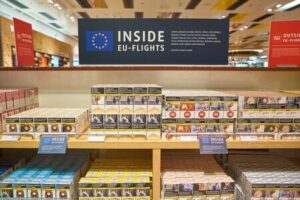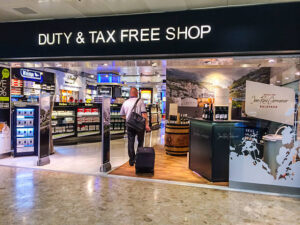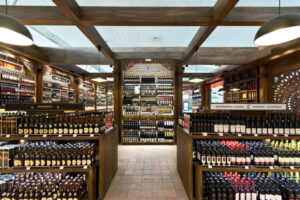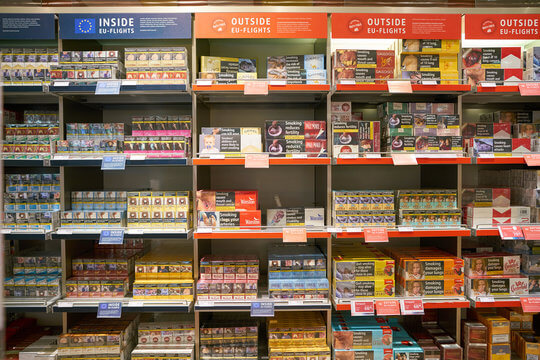When traveling to or from the European Union (EU), it’s essential to understand the EU duty free allowance to avoid being charged extra fees or penalties. Duty-free allowance refers to the amount of goods a person can bring into or take out of the EU without being charged customs duties, value-added tax (VAT), or other taxes. The EU duty free allowance applies to both EU citizens and non-EU citizens, including tourists and business travelers.
How much is EU duty free allowance? How to get EU duty free allowance? A lot of people ask these questions. The duty-free allowance varies depending on the type of goods and the mode of transport. For example, passengers arriving by air or sea have a higher duty-free allowance than those arriving by road or rail. Similarly, the duty-free allowance for alcohol and tobacco is different from that for other goods, such as electronics or clothing.
Understanding the duty-free allowance is important for several reasons. Firstly, it helps travelers avoid paying unnecessary customs duties, VAT, or other taxes when entering or leaving the EU. Secondly, it helps prevent delays and confusion at customs checkpoints, which can be time-consuming and stressful.
Moreover, understanding the duty-free allowance can help travelers plan their purchases and avoid buying goods that exceed the allowed limits. This is particularly important for alcohol and tobacco products, which can quickly add up in value and quantity. Exceeding the duty-free allowance can result in confiscation of the goods, fines, and even legal action.
What is EU Duty-Free Allowance?

Before visiting Europe you should also take into consideration new travel regulations. European Travel Information and Authorization System is the new European Union framework for European travel. Therefore, ETIAS is designed to enhance the Union’s security capabilities. On top of that, it is going to be ensuring a smooth and enjoyable traveling experience.
What types of goods are included in the duty-free allowance?
Duty-free allowances are divided into two categories: restricted and unrestricted goods. Unrestricted goods refer to those without any special regulations or limits, like clothing, electronics, or personal items; on the other hand, restricted items have specific limitations such as alcohol, tobacco, and perfume.
For instance, the duty free allowance tobacco and alcohol products are strictly limited, as stated in the introduction. Other restricted items include firearms, endangered species, and counterfeit goods which are subject to stringent regulations and controls. Duty free shopping at the airport is a popular way to take advantage of the duty-free allowance UK from EU 2025.
How to Assess the Value of Goods:
Travelers wishing to determine the value of goods purchased outside the EU should keep all receipts and invoices for such purchases. The purchase price plus any taxes or duties paid in their destination country are all factors in calculating this value.
If a traveler brings goods into the EU that exceed their duty-free allowance, they must declare them at customs and pay any applicable taxes or duties. Failure to declare goods can result in confiscation, fines, and legal action.
In conclusion, the EU duty free allowance is an invaluable concept for travelers to and from Europe. It’s essential to comprehend its contents, limitations and restrictions, as well as how to value items included within it. By adhering to these guidelines, travelers can avoid unnecessary fees and penalties and make their journey smoother and more enjoyable. It’s important to be aware of the duty free allowance by country to avoid exceeding the limit.
Duty-Free Allowance Limits

For non-EU residents arriving by air or sea, the duty-free allowance limit is higher than for those arriving by road or rail. EU residents do not have any duty-free allowances when traveling within the EU.
For non-EU residents arriving by air or sea, the duty-free allowances are as follows:
- 200 cigarettes or 100 cigarillos or 50 cigars or 250g of tobacco
- 4 liters of still wine and 16 liters of beer and 1 liter of spirits or 2 liters of fortified or sparkling wine
- Other goods up to a value of €430 per person
For non-EU residents arriving by road or rail, the duty-free allowances are as follows:
- 40 cigarettes or 20 cigarillos or 10 cigars or 50g of tobacco
- 1 liter of spirits or 2 liters of fortified or sparkling wine and 4 liters of still wine and 16 liters of beer
- Other goods up to a value of €300 per person
As for EU residents, there are no duty-free allowances when traveling within the EU. However, if they are traveling from the EU to a non-EU country, they have the following duty-free allowances:
- 200 cigarettes or 100 cigarillos or 50 cigars or 250g of tobacco
- 4 liters of still wine and 16 liters of beer and 1 liter of spirits or 2 liters of fortified or sparkling wine
- Other goods up to a value of €300 per person
Explanation of the consequences of exceeding the duty-free allowance limit:

EU duty free alcohol allowance and EU duty free cigarette allowance are also important. For example, if a traveler brings in more than the allowed amount of alcohol or tobacco, they may be subject to additional taxes and duties. If they exceed the allowed value of other goods, they may will have to pay VAT or customs duties. The EU duty free allowance for cigarettes is limited to 800 cigarettes per person, which may not be enough for heavy smokers.
In addition to additional fees, exceeding the duty-free allowance limit can also result in the confiscation of goods, fines, or legal action. It is important for travelers to accurately declare all goods they are bringing into the EU and to comply with the duty-free allowance limits to avoid any negative consequences.
In conclusion, understanding the duty-free allowance limits is crucial for anyone traveling to or from the EU. Travelers should be aware of the different duty-free allowances for different categories of travelers and the consequences of exceeding the limits. By following these guidelines, travelers can avoid unnecessary fees and penalties and make their journey smoother and more enjoyable.
Duty-Free Allowance Limits for EU Residents
EU residents do not have any duty-free allowances when traveling within the EU. However, if they are traveling from the EU to a non-EU country, they have the following duty-free allowances:
- 200 cigarettes or 100 cigarillos or 50 cigars or 250g of tobacco
- 4 liters of still wine and 16 liters of beer and 1 liter of spirits or 2 liters of fortified or sparkling wine
- Other goods up to a value of €300 per person
If an EU resident exceeds their duty-free allowance limit when traveling from the EU to a non-EU country, they may be subject to additional taxes, duties, or penalties. The consequences of exceeding the duty-free allowance limit depend on the type of goods and the amount by which the limit was exceeded.

In addition to additional fees, exceeding the duty-free allowance limit can also result in the confiscation of goods, fines, or legal action. It is important for EU residents to accurately declare all goods they are bringing out of the EU and to comply with the duty-free allowance limits to avoid any negative consequences.
Duty free allowance travelling from UK to EU varies depending on the type of goods and the country you’re travelling to.
Duty-Free Allowance Limits for Non-EU Residents
- Non-EU residents entering the EU by air or sea have a higher duty-free allowance limit than those entering by road or rail. The duty-free allowances for non-EU residents arriving by air or sea are as follows:
- 200 cigarettes or 100 cigarillos or 50 cigars or 250g of tobacco
- 4 liters of still wine and 16 liters of beer and 1 liter of spirits or 2 liters of fortified or sparkling wine
- Other goods up to a value of €430 per person
The duty-free allowances for non-EU residents arriving by road or rail are as follows:
- 40 cigarettes or 20 cigarillos or 10 cigars or 50g of tobacco
- 1 liter of spirits or 2 liters of fortified or sparkling wine and 4 liters of still wine and 16 liters of beer
- Other goods up to a value of €300 per person
If a non-EU resident exceeds their duty-free allowance limit when entering or leaving the EU, they may be subject to additional taxes, duties, or penalties. The consequences of exceeding the duty-free allowance limit depend on the type of goods and the amount by which the limit was exceeded.
For example, if a non-EU resident brings in more than the allowed amount of alcohol or tobacco, they may be subject to additional taxes and duties. If they exceed the allowed value of other goods, might have to pay VAT or customs duties.
As mentioned above, ETIAS will play a huge role in world travel starting from 2025. On the bright side ETIAS application process is a simple procedure. After submission, your application will go through several security databases, checking the legitimacy of your provided information.
In addition to additional fees, exceeding the duty-free allowance limit can also result in the confiscation of goods, fines, or legal action. It is important for non-EU residents to accurately declare all goods they are bringing into or out of the EU and to comply with the duty-free allowance limits to avoid any negative consequences.
How to Calculate Duty on Goods

To calculate the duty and taxes payable, follow these steps:
- Determine the value of the goods including any shipping or insurance costs.
- Find the appropriate tariff code for the imported goods. This code determines the rate of duty payable.
- Calculate the duty payable by multiplying the value of the goods by the duty rate.
- Calculate any applicable taxes such as VAT or excise duty by adding the value of the goods and duty payable and multiplying this by the relevant tax rate.
Examples of duty calculation:
For example, if a non-EU resident brings in €600 worth of clothing into the EU, the value of the goods above the duty-free allowance is €270. If the tariff rate for clothing is 10%, the customs duty payable is €27 (€270 x 10%). If the VAT rate is 20%, then the VAT payable is €54 ((€270 + €27) x 20%).
Another example is if a non-EU resident brings in 1 liter of spirits into the EU. The duty rate for spirits is €1.6 per liter of pure alcohol. If the alcohol content of the spirits is 40%, then the pure alcohol content of 1 liter is 0.4 liters. Therefore, the customs duty payable is €0.64 (0.4 liters x €1.6). If the VAT rate is 20%, then the VAT payable is €0.13 ((€0.64 + €0.64) x 20%).
Other EU Tax and Duty Information

Tips for travelers to avoid overpaying taxes and duties:
To avoid overpaying taxes and duties, travelers should be aware of the duty-free allowances for the type of goods they are bringing into the EU. They should accurately declare all goods they are bringing in and their value. If unsure about the value of an item, travelers can check online or with customs officials. Additionally, travelers should keep all receipts and documentation to show the value of their goods.
Links to additional resources for more information:
For more information on EU tax and duty regulations, travelers can visit the website of the European Commission or the customs website of the country they are visiting. The website of the International Air Transport Association (IATA) also provides information on duty-free allowances and other travel-related regulations.
Conclusion
In conclusion, understanding EU duty free allowances is crucial for travelers to avoid overpaying taxes and duties when bringing goods into the EU. It is important to know the duty-free allowances for different categories of travelers and how to calculate duty on goods that exceed the limit. By being aware of these regulations and properly declaring goods, travelers can enjoy a hassle-free and cost-effective travel experience in the EU.
Researching duty free allowances by country can help you make the most of your international travel experience.
